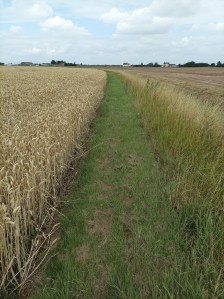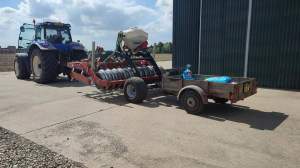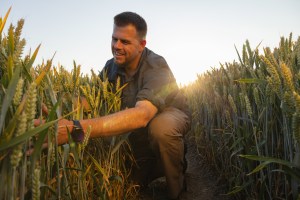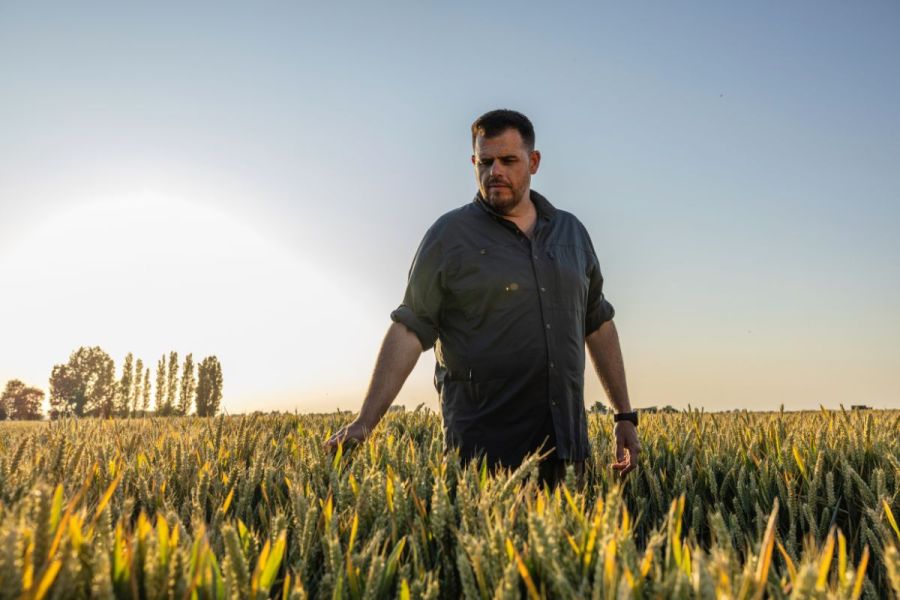Making small improvements is helping to keep a Norfolk farmer ahead of blackgrass. CPM learns more about his approach to grassweed control.
“Most farmers would be millionaires if they could farm with hindsight.”
By Mike Abram
It’s the little things that matter when you have a grassweed problem you’re striving to keep under control. That’s why David Hurn has a 1m-wide mower on the back of a small tractor during the early summer months.

Mowing the outsides of all fields is helping to keep grassweeds under control.
“It’s one of the things we do which I think is very important,” he says. “We use it to mow around the outsides of all of our fields three times – from as soon as the grassweeds start heading in the spring, then after they’ve grown back and started heading again, and lastly just before harvest.”
The main purpose is to reduce seed ingress from blackgrass, but to also help with other potential problems such as bromes and Italian ryegrass. “With other grassweeds coming into farming, this sort of thing is a must. When there are 9-12m headers on combines, just 5-10cm of grassweed ingress on the headlands can soon be 6m into the field the following year.
“It’s a really important part of my integrated weed management approach because I’m not using a herbicide and it’s cost-effective,” says David.
The 150ha west Norfolk farm’s problem with blackgrass began in the early 2000s, a few years after it decided to stop growing potatoes.
“We used to grow pre-pack with ambient bulk storage but things were moving towards cold storage and high investment. For the area we grew we decided that investment was too big, so stopped growing them.”
The knock-on effect of reducing the cropping diversity and beginning to lose chemical options led to too many wheats and the rise of blackgrass. “We’ve never been loused up with it, but it’s a constant war of attrition. We’re very aware you don’t have to see many blackgrass plants to experience many more the following year.”

David Hurn says his approach to cultivation isn’t minimum tillage and it’s not ploughing, it’s somewhere in the middle.
A more integrated approach to managing the threat started soon after David took over day-to-day running of the farm in the late 2000s.
“I could see we had to modernise, so some of the first steps were to use stale seedbeds, delayed drilling and a reduced cultivation system with Sumo Trio, rather than the plough-based system we were using,” says David. “It’s not minimum tillage and it’s not ploughing, it’s somewhere in the middle.”
Those tactics are still mainstays of the current plan in a rotation consisting of two wheats, a spring barley, two wheats and sugar beet.
Partly because of workloads, stubbles are left for around three weeks after harvest, after which David goes through with the Sumo to create a stale seedbed. Before setting up the Trio, he usually has a dig in the field to work out how deep the cultivation has to be.
“We look at soil structure and check for compaction, and then decide on the depth required,” he explains. This is followed by checking in the field by feeling the wear on the points. “You tend to find where the hotspot is, is where the pan is. If that’s 10cm above the point, it’s probably too deep so we’ll ease it out a little.”
Using the Sumo has a couple of advantages, he believes. As well as leaving a weatherproof finish, to the extent he now prepares spring crop land with the implement in the autumn rather than ploughing, it also reduces the number of clods.
“We know how much blackgrass likes to hide behind a clod. I think a reduced tillage seedbed is better for the desiccation of blackgrass than a ploughed one, unless you’re prepared to use more diesel to knock it down to reduce that clod size.”
Ploughing is now only used as a rotational tool, most often following sugar beet, or to act as a useful reset button when required. “If, for example, on some of our heavier land we’ve used our reduced tillage system for five or six years and we’re starting to see a little more blackgrass creeping in, we’ll pull it down and then plough to make sure we achieve good inversion, before creating a stale seedbed and spring cropping.
“It’s a good reset which means we can have another five or six years. I don’t like ploughing any tighter than one year in five unless I’m forced to.”

The farm is using the Sumo Trio for advantages such as leaving a weatherproof finish and reducing the number of soil clods.
Wheat is typically drilled from around mid-October, following at least one, but preferably two, stale seedbeds. “If we haven’t had at least one, I won’t drill,” says David.
On some of his heavier soils, mid-November is the latest he can realistically plan to drill wheat. But he admits that in some years, if the long-range weather forecast is looking unfavourable, he can be tempted into drilling earlier.
“Last year, I was slightly earlier by a couple of days as the forecast talked of at least a fortnight of wet weather. As it turned out, we didn’t really have anything of significance until well into November, so with hindsight I could have waited.
“Of course, hindsight is a very exact science. Most farmers would be millionaires if they could farm with hindsight.”
David is trying to be precise with the seed rates he uses, varying according to soil type and blackgrass risk. It’s part of a plan to both digitise the farm and use precision agriculture techniques that’s been in place since around 2014.
“I knew to move forward we had to map the farm digitally, so started to variably rate P and K. From there we moved to variable rate drilling, which is part of the picture of how we deal with blackgrass now, as we vary our seed rates across different soil types.”
He typically aims to drill around 250 seeds/m2 but has some fields where he’ll use 40% more in some parts than others.
“Some might think that’s extreme, but it doesn’t look any thicker where we’ve used very high seed rates than the better end of the field.
“We know those areas are heavier soils and wetter, and hence know they’re going to have more blackgrass so if we can increase populations to increase competition, that should help,” explains David.
As well as using seed rate to compete with blackgrass, David also tries to grow a variety which gets out of the blocks quickly to compete. He avoids ones that sit prostrate over winter not growing while the blackgrass is.

A lack of crop competition was one of the reasons for some of the poorer blackgrass control seen this season, says Matthew Keane.
A lack of crop competition was one of the reasons for some of the poorer blackgrass control seen this season, adds Matthew Keane, David’s local BASF agronomy manager. “With the wet spring some varieties just didn’t get going. You can have reasonable control of blackgrass from autumn residuals, but if it’s not being out-competed by the crop, the ones that are left can tiller well. This means a lot of blackgrass heads from fewer plants, which is not what you want,” he says.
“We found one blackgrass plant in a demonstration trial where we had no crop competition which had 110 heads. This shows what a blackgrass plant can do without competition – it can tiller out fairly aggressively,” says Matthew.
David currently grows Skyscraper as a soft Group 4 feed wheat and Gleam and Dawsum as hard Group 4s, which he stores separately. “It’s probably our last year with Dawsum as it seems a little slow. Next year, I’m likely to grow Bairstow, which looks similar to Skyscraper but with a better disease resistance package so should cost me a little less to grow, and also Typhoon.”
David explains that chemical control relies on residual chemistry and the farm was never a big user of mesosulfuron-containing products, only using them around four times in total due to concerns over timing and efficacy. “We try to control the problem before we have to worry about it in the spring. That’s the philosophy,” he says.
Up until last season, that was typically based on a Crystal (flufenacet+ pendimethalin) plus diflufenican pre-emergence, with the occasional field having a follow-up application of Defy (prosulfocarb).
But with new option Luxinum Plus (cinmethylin) available, David chose to switch. “It’s more expensive, but we still have some blackgrass in fields and an uplift in control is valuable. It can also improve control of other grassweeds.”

According to David Hurn, despite being more expensive, Luximo is worth it due to the uplift it offers in grassweed control.
That uplift in blackgrass control is around 20% across the trials BASF has carried out when directly comparing Luximo with flufenacet, or 12% comparing Luxinum Plus plus pendimethalin and diflufenican, versus Liberator (flufenacet+ diflufenican) plus Proclus (aclonifen), says Matthew.
“The uplift in control with Italian ryegrass is higher at around 30%, and it’ll also easily control annual meadow grass. Added into that, you have broadleaf weed control with poppy, as well as what comes if you add DFF to pendimethalin.”
In a couple of fields where there was higher blackgrass pressure, partly as a result of growing third or even fourth wheats while trying to get the rotation back on track following the difficult autumn of 2019/20, David topped up the Luxinum Plus with 2.0 L/ha of Crystal.
“In a year like this one, where control was poorer, it was the best thing you could have done,” suggests Matthew. “Doubling down on good control of blackgrass is important. Lots of growers took the choice to use a strong pre-emergence herbicide and then call it a day, partly because of higher costs.
“But those products are only going to last six to eight weeks, not six to eight months. With prolonged germination and a lack of crop competition in some cases, there’s only so much pre-emergence chemistry can do, especially in the hard conditions with dry seedbeds we saw last year,” he says.
As well as the overall result, David was impressed by how easily the cans washed out. “On a small farm like ours, that might not be such a big deal, but on a farm with 400ha of wheat to spray, being able to wash out quickly and efficiently is fantastic.
“It will be our standard pre-emergence treatment for us now,” he concludes.
This article was taken from the latest issue of CPM. Read the article in full here.
For more articles like this, subscribe here.
Sign up for Crop Production Magazine’s FREE e-newsletter here.




